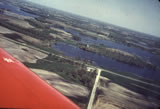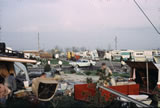NWS Twin Cities Home Page » Historical Severe Weather Events » May 6, 1965 Tornado Outbreak
The May 6, 1965 Tornadoes
The worst tornadoes in Twin Cities history occurred forty years ago, with five tornadoes sweeping across the western and northern portions of the 7-county region, and a sixth tornado just outside the metropolitan area. Four tornadoes were rated F4, one was an F3, and the other produced F2 damage. Thirteen people were killed and 683 injured. Many more would have been killed had it not been for the warnings of the U.S. Weather Bureau, local officials, and the outstanding communications by local radio and television stations. Many credit the announcers of WCCO-AM with saving countless lives. It was also the first time in Twin Cities history that civil defense sirens were used for severe weather.
There were two photographs of tornadoes - the Deephaven tornado and the second Fridley tornado were both published in the Minneapolis Tribune. It is unknown whether anybody else took pictures of any of the tornadoes that day.
Recently discovered radar archives of this tornado outbreak are available at the bottom of this page.
U.S Weather Bureau Principal Assistant Joseph H Strub, Jr. (who would later become Meteorologist-in-Charge) assembled 36 slide photographs of damage from the May 6, 1965 tornadoes. Some time ago, these were discovered in a box of photos at the National Weather Service, and we are pleased to present them here (although two of them are too blurry to be included). Notes written by Mr. Strub accompanied the photos. The 36 slides and notes did not cover all six tornadoes.
In the weeks following the tornadoes, the slides were numbered according to the tornado that was believed to have inflicted the damage. Specifically, Mr. Strub labeled the first tornado as starting at 6:27 p.m., moving from Chanhassen to Deephaven to North Minneapolis and Fridley, and he numbered these pictures 101 through 109. He indicated tornado #2 as starting near Green Isle at 6:50 p.m., ending near Hamel, and he numbered them in the 200s. He listed the fifth tornado as starting at 8:10 p.m., stated it was the second tornado to hit Fridley, and labeled them in the 500s. The written summary contained in the May 1965 edition of Storm Data described these specific tracks and times, and also mentions three tornadoes as having hit Fridley. These images are available in the middle of this page.
This information was believed to be true through the balance of the 1960s, and even into the early 1970s. State Climatologist Earl Kuehnast, probably in 1970, produced a map showing tornado tracks in the 1960s, including three tornadoes moving across Fridley on May 6.
Forty years later, the most intriguing question concerns the 1973 correction to the original tornado data assigned in 1965. Tornado tracks and times were changed, and the number of fatalities was reduced from 14 to 13. Updated maps are also available.
Today, there is no information at the National Weather Service or State Climatology as to why the data were revised. Three hand-sketched maps showing the new data were uncovered from the files of Earl Kuehnast, and they are dated January and February 1973. Mr. Kuehnast even placed a large "X" across the 1965 version, clearly indicating he no longer believed the original map to be correct. Two maps published in 1975 show the revised information - these are in "Climate of Minnesota, Part VIII - Precipitation Patterns in the Minneapolis-St. Paul Metropolitan Area and Surrounding Counties." and can be seen at http://climate.umn.edu/pdf/climate_of_minnesota/comVIII.pdf, pages 30 through 32.
Meteorologist-in-Charge Joe Strub apparently agreed with Kuehnast's 1973 revision, because official Storm Data records at NOAA's National Climatic Data Center were updated, and the following are now the official NOAA records:
Tornado #1 touched down at 6:08 p.m. CST just east of Cologne ( Carver County), was on the ground for 13 miles, and dissipated in the northwestern portion of Minnetrista ( Hennepin County). It was rated an F4, killed three people and injured 175.
Tornado #2 touched down at 6:27 p.m. CST near Lake Susan in Chanhassen ( Carver County) and traveled 7 miles straight north to Deephaven ( Hennepin County). It was rated an F4, was on the ground for 7 miles, but resulted in no injuries or fatalities.
Tornado #3 touched down at 6:34 p.m. CST about 3 miles east of New Auburn ( Sibley County) and moved to just west of Lester Prairie ( McLeod County). On the ground for 16 miles, it was rated an F3, but there were no injuries or fatalities.
Tornado #4 touched down at 6:43 p.m. CST about two miles east of Green Isle (Sibley County), was on the ground 11 miles, and dissipated about two miles southwest of Waconia (Carver County). It was rated an F2, killed one person, and injured 175.
Tornado #5 touched down at 7:06 p.m. CST in the southwesternmost corner of Fridley ( Anoka County), moved across the Northern Ordnance plant, and dissipated just northeast of Laddie Lake in Blaine ( Anoka County). It was on the ground for 7 miles, reached F4 intensity, killed three people and injured 175.
Tornado #6 touched down at 8:14 p.m. CST in Golden Valley, moved across north Minneapolis ( Hennepin County) and into Fridley ( Anoka County), then Mounds View ( Ramsey County), and finally dissipated just west of Centerville ( Anoka County). This was rated an F4, killed six people and injured 158, and was on the ground for 18 miles.
The following is an assortment of photos from the storms that occurred on May 6, 1965. The captions indicate the source of the photos. Clicking on the thumbnails will display a larger copy of the image.
Following are descriptions of the numbered photos, taken from the summary compiled by Joe Strub in 1965, with additional details by Warning Coordination Meteorologist Todd Krause in 2005. Clicking on the thumbnail images will display a larger image.
Radar footage from 1965 was recently discovered, and the 35mm film was converted to digital format, although there was no method available to us other than a somewhat crude technique. So we present them "as is," with little indication of how distant the storm was from the radar, or without any map backgrounds. It will take quite some time, but we hope some day to assign high resolution map backgrounds and possibly filter the radar echoes to highlight the most important storms. This will allow us to study the event in greater detail and learn important lessons from this historic tornado outbreak.
The clock uses 24 hour timing, and is in Central Standard Time. For example, 1800 would be 6:00 p.m. CST, and 2100 would be 9:00 p.m. CST.






































